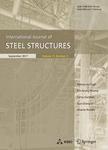版权所有:内蒙古大学图书馆 技术提供:维普资讯• 智图
内蒙古自治区呼和浩特市赛罕区大学西街235号 邮编: 010021

作者机构:Sunmoon Univ Div Architecture Architectural & Civil Engn Asan South Korea Yeungnam Univ Sch Architecture Gyongsan South Korea
出 版 物:《INTERNATIONAL JOURNAL OF STEEL STRUCTURES》 (国际钢结构杂志)
年 卷 期:2018年第18卷第5期
页 面:1598-1606页
核心收录:
学科分类:08[工学] 0802[工学-机械工程] 0814[工学-土木工程]
基 金:National Research Foundation of Korea (NRF) - Korea government(MSIP) [NRF-2017R1A2B4006226]
主 题:Integrated structural optimal design Diagrid structural system Smart tuned mass damper Multi-objective genetic algorithm Vibration control Wind excitation Earthquake load
摘 要:An integrated optimal structural design method for a diagrid structure and control device was developed. A multi-objective genetic algorithm was used and a 60-story diagrid building structure was developed as an example structure. Artificial wind and earthquake loads were generated to assess the wind-induced and seismic responses. A smart tuned mass damper (TMD) was used as a structural control system and an MR (magnetorheological) damper was employed to develop a smart TMD (STMD). The multi-objective genetic algorithm used five objectives including a reduction of the dynamic responses, additional stiffness and damping, mass of STMD, capacity of the MR damper for the integrated optimization of a diagrid structure and a STMD. From the proposed method, integrated optimal designs for the diagrid structure and STMD were obtained. The numerical simulation also showed that the STMD provided good control performance for reducing the wind-induced and seismic responses of a tall diagrid building structure.